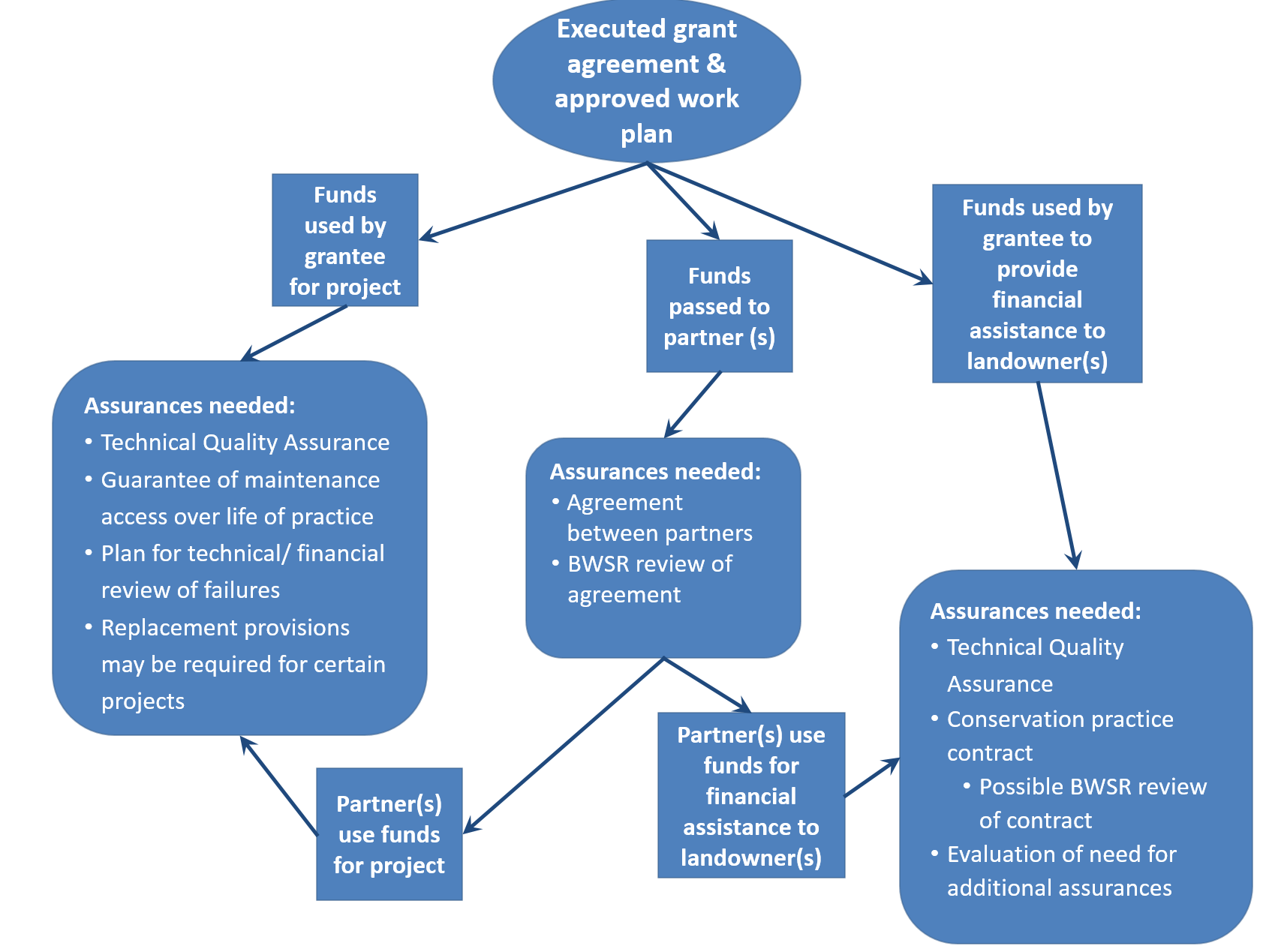Effective Date: 07/01/2022
Project and Practice Assurance Responsibility
BWSR requires assurances from grantees that installed conservation practices and projects meet the purposes of the grant program, will remain in place for the lifespan expected, and will provide the water quality benefits for which they were designed. Factors such as grant program requirements, partners, landownership, type of practices, and cost influence what type of and when certain assurances are required or used.
BWSR has identified three primary levels of assurance:
- The first level of assurance is the executed grant agreement and associated approved work plan, if applicable, between BWSR and the grantee.
- The next level is Technical Quality Assurance (TQA) that requires conservation practices and projects to be installed according to appropriate technical standards and designs; with appropriate technical and/or engineering expertise and oversight; and with thorough post-construction operation, maintenance, and inspections. Additionally, access for inspections, operation, and maintenance must be maintained with this level of assurance.
- The final level of assurance varies by statute, rule, policy, grant agreement, or through local decision. This level of assurance may include such activities as: a conservation practice contract with the participating land occupier, an agreement with a partner organization, recording the practice(s) with the property title, easements, or other means to guarantee the long-term environmental benefits of the project are met.
Contracts
Conservation practice or financial assistance contracts between grant recipients and landowners are required when funds are used to provide financial assistance to install practices. When used, these contracts must, at a minimum: provide financial assistance information and expectations; identify the responsibility for operation and maintenance, including maintenance or control of the contributing watershed; include a technical and financial plan for failures; allow for inspections by the grantee of the practice; be in effect for a period corresponding to the expected life of the project; and may be required to include replacement provisions and pro-rated pollution effectiveness replacement. For practices installed on public land, operation and maintenance plans may be identified as part of capital infrastructure maintenance. Some grants require BWSR review of contracts prior to implementation. All contracts are recommended to be reviewed by the grantee’s legal counsel.
Tennessen Warning Notice
Local Governments must give individuals notice when collecting private or confidential information from them. This is referred to as a “Tennessen warning notice”. The purpose of the notice is to enable people to make informed decisions about whether to give information about themselves to the government (see Minnesota Statutes, section 13.04, subdivision 2). If Private Data is collected and disseminated as part of a BWSR Grant, BWSR will take the position that a Tennessen warning notice was provided by the LGU to all necessary individuals.
- Local Governments and grant recipients should ask the individual(s) to sign and date a Tennessen warning notice and give the individual(s) a copy as a best practice. However, notices do not need to be in writing.
- Local Governments and grant recipients should limit the private data collected or disseminated to only the data that is necessary to administer a program.
- Local Governments may also want to request assistance from their legal counsel.
Sub-Agreements
When passing funds to partner(s), an agreement and work plan regarding fund distribution, reporting, and project approval between partners is required. BWSR review and approval of these agreements may be required; see the assignments section of the grant agreement and contact your Board Conservationist for more information.
Operation and Maintenance
Operation and Maintenance (O&M) plans for practices within their expected lifespan require assurances that the land occupier(s) will keep those practices in place for their intended use and lifespan (such as easements, deed recordings, enforceable contracts, performance bonds, letters of credit, and termination or performance penalties) as well as inspection reports on those practices (including practices and projects involving incentives, such as nutrient management plans), according to the schedule outlined in the plan. Details required in the Operation and Maintenance Plan may be further defined in a given grant program policy.
The diagram below outlines scenarios when assurances are required or may be needed. In general, the assurances required of primary grantees are also required of project partners, including those that receive portions of the original grant for use in project activities.
Some grants may have requirements in addition to those noted here that may influence grant eligibility. For example, BWSR may act as the fiscal agent on behalf of other State agencies, such as MPCA SSTS Program and DNR Shoreland Program. These agencies may have requirements beyond information BWSR has requested.
Minnesota Statutes §103B.3369, Subdivision 9 allows BWSR to consider additional performance-based criteria for grant programs. And, the Office of Grant Management Policy on Grant Closeout Evaluation (08-13) requires BWSR to consider a grant applicant’s past performance when awarding grants. BWSR may consider withholding grant payments if the grantee is not in compliance with ALL Board reporting requirements.
If you have questions or are unable to complete a required report by a given deadline, contact your Board Conservationist.
|
Description of revisions |
Date |
|
No significant changes from prior year; updated format and language and incorporated diagram. |
7/1/2017 |
|
Information on Tennessen warning notices was added under the Contracts section. |
7/1/2022 |

